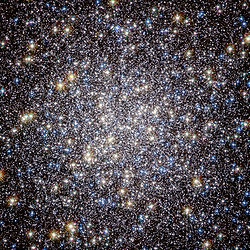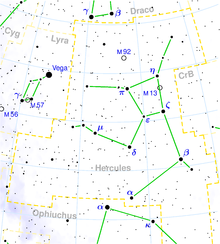- Messier 13
-
This article is about the globular cluster M13. For the galaxy cluster in Hercules, see Abell 2151.
Messier 13 
The heart of Hercules Globular Cluster;
Credit: ESA/Hubble and NASAObservation data (J2000 epoch) Class V Constellation Hercules Right ascension 16h 41m 41.44s[1] Declination +36° 27′ 36.9″[1] Distance 25,100 light years Apparent magnitude (V) +5.8[1] Apparent dimensions (V) 20 arcmins Physical characteristics Mass 6×105 [2] M☉ (1036 kg) Radius 84 ly[3] Estimated age 1.4×1010 yr Notable features one of the
best-known clusters
of the northern
hemisphereOther designations NGC 6205[1] See also: Globular cluster, List of globular clusters Messier 13 or M13 (also designated NGC 6205 and sometimes called the Great Globular Cluster in Hercules or the Hercules Globular Cluster) is a globular cluster of about 300,000 stars in the constellation of Hercules.
Contents
Discovery and visibility
M13 was discovered by Edmond Halley in 1714, and catalogued by Charles Messier on June 1, 1764.
It is located at right ascension 16h 41.7m and declination +36° 28'. With an apparent magnitude of 5.8, it is barely visible with the naked eye on a very clear night. Its diameter is about 23 arc minutes and it is readily viewable in small telescopes. Nearby is NGC 6207, a 12th magnitude edge-on galaxy that lies 28 arc minutes directly north east. A small galaxy, IC 4617, lies halfway between NGC 6207 and M13, north-northeast of the large globular cluster's center.
Characteristics
M13 is about 145 light-years in diameter, and it is composed of several hundred thousand stars, the brightest of which is the variable star V11 with an apparent magnitude of 11.95. M13 is 25,100 light-years away from Earth.
Arecibo message
The Arecibo message of 1974, designed to communicate the existence of human life to hypothetical extraterrestrials, was transmitted toward M13. The reason was that with a higher star density, the chances of a life harboring planet with intelligent life forms, were believed to be higher. Even though the message was transmitted, M13 will no longer be in that location when it arrives. The sending of the message was more of a technological demonstration, rather than an actual attempt to contact life.
Literary references
- The science fiction novellas "Sucker Bait" by Isaac Asimov and "Question and Answer" by Poul Anderson take place on Troas, a world within M13.
- In the science fiction series Perry Rhodan, M13 is the location of Arkon, the home world of the race of Arkonides.
- In author Dan Simmon's Hyperion Cantos the Hercules cluster is where Earth was secretly moved to after it was supposedly destroyed.
- In The Sirens of Titan, Kurt Vonnegut writes "Every passing hour brings the Solar System forty-three thousand miles closer to Globular Cluster M13 in Hercules -- and still there are some misfits who insist that there is no such thing as progress."
- Deliberately engineering a star in Messier 13 to go nova was part of the Cybermen’s complicated plot in the 1968 Doctor Who story The Wheel in Space.
- In Bill Amend's popular comic strip FoxTrot, Jason Fox mentions observing the M13 Globular Cluster
See also
References
- ^ a b c d "SIMBAD Astronomical Database". Results for NGC 6205. http://simbad.u-strasbg.fr/Simbad. Retrieved 2006-11-15.
- ^ Leonard, Peter J. T.; Richer, Harvey B.; Fahlman, Gregory G. (1992). "The mass and stellar content of the globular cluster M13". Astronomical Journal 104: 2104. Bibcode 1992AJ....104.2104L. doi:10.1086/116386.
- ^ distance × sin( diameter_angle / 2 ) = 84 ly radius
External links
- Messier 13, SEDS Messier pages
- Messier 13, Galactic Globular Clusters Database page
- Messier 13, High-resolution LRGB image based on 2 hrs total exposure
- M13 Hercules Globular photo detail Dark Atmospheres
- Messier 13, Image by Waid Observatory
- NightSkyInfo.com - M13, the Hercules Globular Cluster
- Photometric study of the V2 cepheid in M13
- Period, Amplitude and Light Curve of V38 in M13
- Great Globular Cluster in Hercules (Messier 13/NGC 6205)
- Messier 13 on WikiSky: DSS2, SDSS, GALEX, IRAS, Hydrogen α, X-Ray, Astrophoto, Sky Map, Articles and images
Coordinates:
 16h 41m 41.44s, +36° 27′ 36.9″
16h 41m 41.44s, +36° 27′ 36.9″Messier objects List M1 · M2 · M3 · M4 · M5 · M6 · M7 · M8 · M9 · M10 · M11 · M12 · M13 · M14 · M15 · M16 · M17 · M18 · M19 · M20 · M21 · M22 · M23 · M24 · M25 · M26 · M27 · M28 · M29 · M30 · M31 · M32 · M33 · M34 · M35 · M36 · M37 · M38 · M39 · M40 · M41 · M42 · M43 · M44 · M45 · M46 · M47 · M48 · M49 · M50 · M51 · M52 · M53 · M54 · M55 · M56 · M57 · M58 · M59 · M60 · M61 · M62 · M63 · M64 · M65 · M66 · M67 · M68 · M69 · M70 · M71 · M72 · M73 · M74 · M75 · M76 · M77 · M78 · M79 · M80 · M81 · M82 · M83 · M84 · M85 · M86 · M87 · M88 · M89 · M90 · M91 · M92 · M93 · M94 · M95 · M96 · M97 · M98 · M99 · M100 · M101 · M102 · M103 · M104 · M105 · M106 · M107 · M108 · M109 · M110See also  Book:Messier objects ·
Book:Messier objects ·  Category:Messier objects
Category:Messier objects  Portal:AstronomyCategories:
Portal:AstronomyCategories:- Globular clusters
- Hercules constellation
- Messier objects
- NGC objects
Wikimedia Foundation. 2010.

